How to Increase Energy Levels with Diet

Written by Dr Estrelita van Rensburg
Introduction - how to increase energy with diet
Do you feel tired and wish you had more energy? Would you say you have enough energy throughout the day? If your body runs on low energy levels, your eating habits and food choices need a shake-up.
Our body can use two types of fuel for everything it needs: glucose (from carbohydrates such as sugar and starch) or ketones (from healthy fats, including saturated fat).
Two dominant energy fuels
Of the two types, glucose (blood sugar) is dominant. Glucose is the breakdown product of all sugar and starch molecules. In other words, as long as we keep eating a lot of starchy food and sugar, our body will only use glucose as an energy fuel.
The problem with this scenario is the more carbohydrates we eat the more fat our body stores. This means gaining weight. Another issue is that one often feels hungry on a diet rich in carbohydrates resulting in us eating more….and more. This means storing more fat in the belly area.
If we wish to lose weight, we have to change what we eat.
Two energy fuel tanks in the body
If you are clever and cut back on processed foods which contain refined carbohydrates (starchy food and fizzy sugary drinks, diet versions included), your body will switch over to the second fuel tank – the ketone or fat tank. It runs on your stored body fat as well as healthy fats in your diet. It will give you an energy boost and help with weight loss!
The fat tank is much larger than the glucose tank so ideal for longer journeys - 12-hour shifts, marathons, fasting etc. A sustained energy supply.
The BIG secret is – this tank needs fat to run on! Bingo, it is going to burn your fat stores! YES! Powering your body with ketones, other than to boost energy levels, are the health benefits, especially when our metabolism suffers from eating too many carbohydrates such as refined sugars.
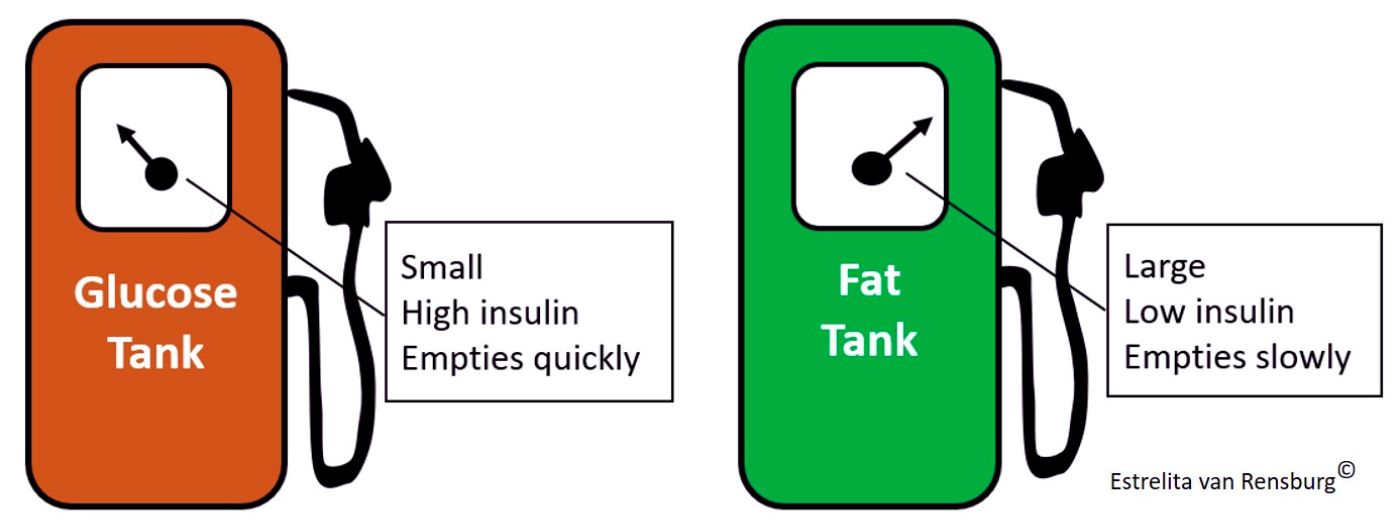
The body can use two energy fuel tanks – glucose (small tank) or fat (large tank).
What is energy fuel?
Energy is required for life. Energy cannot be created or destroyed. It already exists in all substances through the forces that bind molecules together. When these molecules are unbound, energy is released.
A good example to explain the nature of energy is fire. Fire is the result of oxygen in the air combining with carbon and hydrogen molecules in, for example, wood. In this instance, wood is the fuel and its chemical reaction with oxygen releases energy in the form of heat. It is otherwise known as a combustion reaction.
Energy fuel first discovered
It was during the eighteenth century that the French nobleman, Antoine Lavoisier, identified two gases: oxygen and carbon dioxide. These two gases are central to energy metabolism. His experiments showed that the air (oxygen) that animals inhaled reacted with organic molecules inside their bodies and the air they exhaled contained carbon dioxide. The result was that their bodies generated heat: In short - food + oxygen = energy + carbon dioxide. This was the start of understanding our body’s metabolic energy map.1, 2
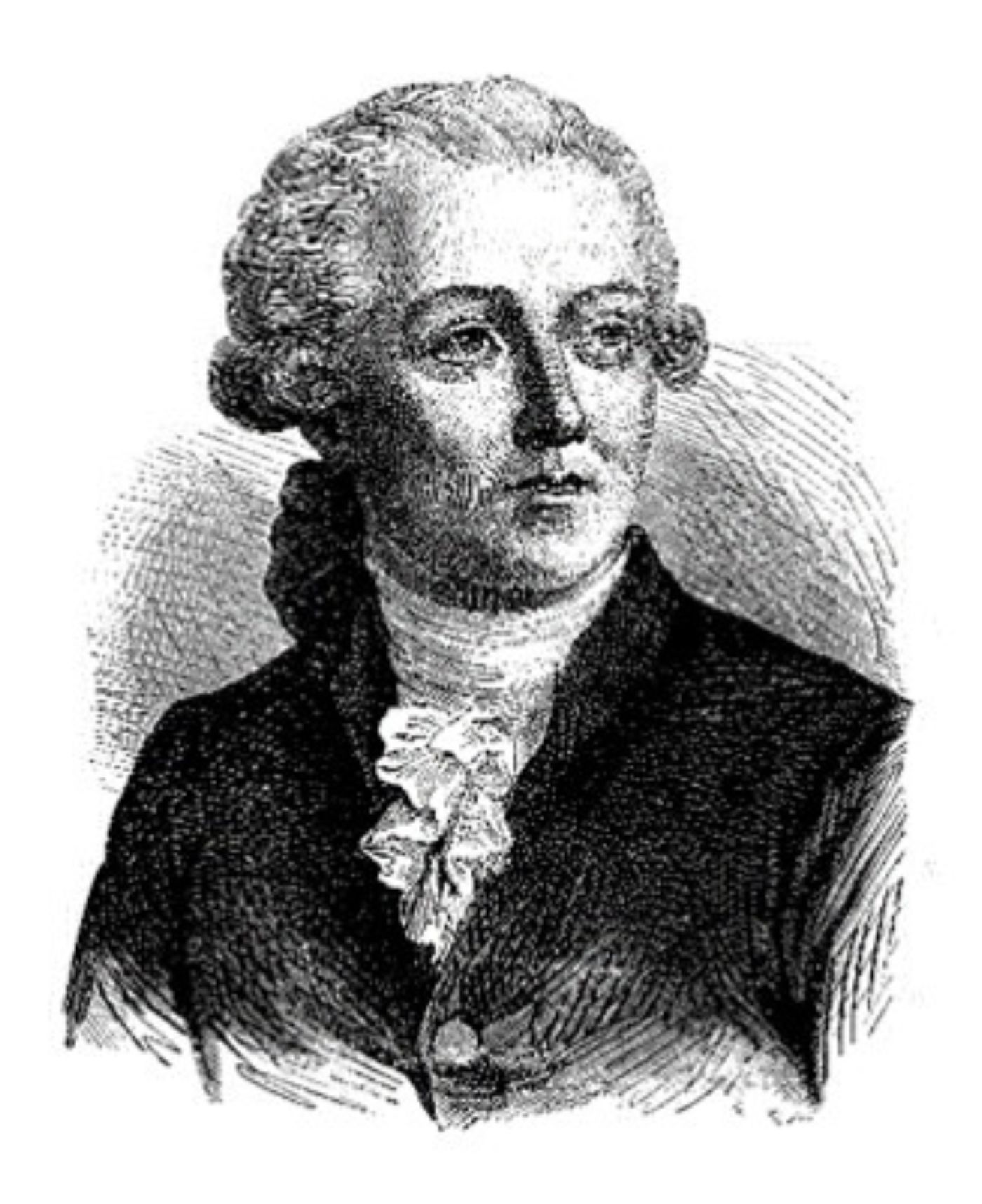
French nobleman Antoine Lavoisier gave oxygen its name in 1777.
Three energy fuel molecules
In our body energy is generated from the food we eat. There are three macronutrients in food. They are: carbohydrates (sugar and starch), fat and protein.
Following digestion in our gut, their end products are - glucose (from carbohydrates), fatty acids/ketones (from lipids) and amino acids (from protein). These end products can all be used as fuel molecules.
Three steps to produce energy fuel
All three of these molecules have different entry points into the energy-producing steps in our cells. The three main steps are:
❶ Glycolysis is the initial breakdown process of glucose;
❷ Eight-step cycle (known as the ‘Krebs cycle'), in which fatty acids from lipids and amino acids from protein enter directly (they don't require the glycolysis step). It is therefore a more energy efficient process - extra energy from fat and protein;
❸ Final step where energy production, in the form of ATP (adenosine triphosphate) takes place. This happens inside mitochondria through a process called the electron transport chain (ETC).
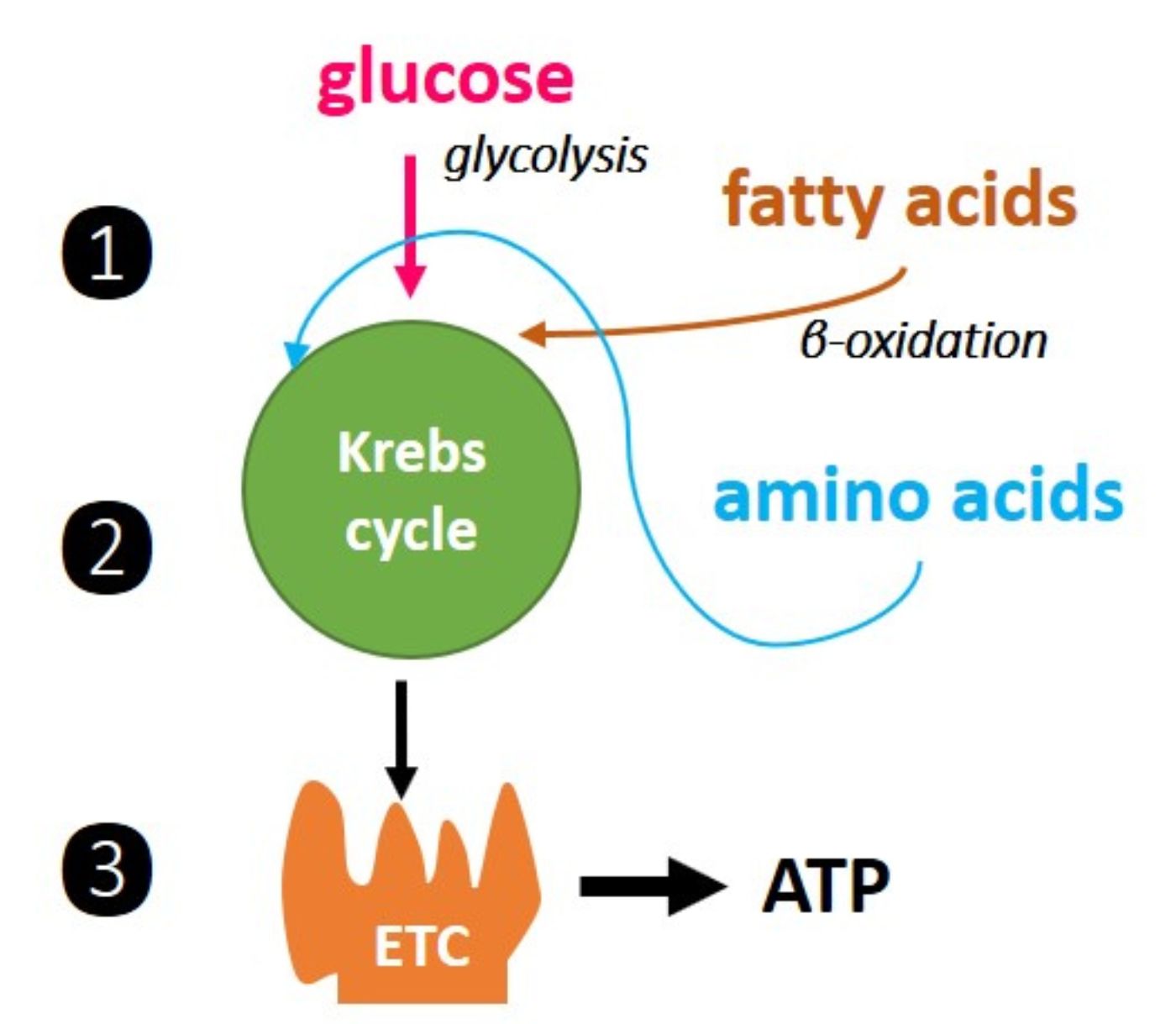
Energy production in the cell goes through 3 phases, using three input molecules - glucose (carbs), fatty acids (fat) and amino acids (protein). Energy output is called ATP, which powers all cellular processes.
Starvation tells us how stored energy is used
In the late 1960, George Cahill, a professor at the Harvard Medical School, became interested in studying the physiology of starvation. His research led him to believe that ketones, far from being waste products of fat metabolism, could have helped our human hunter-gatherer ancestors to survive periods when food was scarce.3
When we eat a normal Western diet, rich in processed foods and carbohydrates, excess glucose is stored in the liver and muscle as glycogen (basically a long chain of glucose molecules). But glycogen storage capacity is limited and can only supply energy for a day or two.
When the glucose/glycogen tank runs out during fasting, the next energy fuel targeted (on a limited scale only), is muscle protein. It is not a good energy source, since we must conserve muscle protein as much as possible.
That leaves us with the third fuel type: fat tissue. In a normal seventy kg man, fat reserves are between ten and twelve kilos in total. That is a very large energy tank. Fuel from our fat stores starts to be released within a few days of starvation.
Depending how large our fat deposits are, it may last for weeks to months. The same process happens when we follow a very low carbohydrate or keto diet.
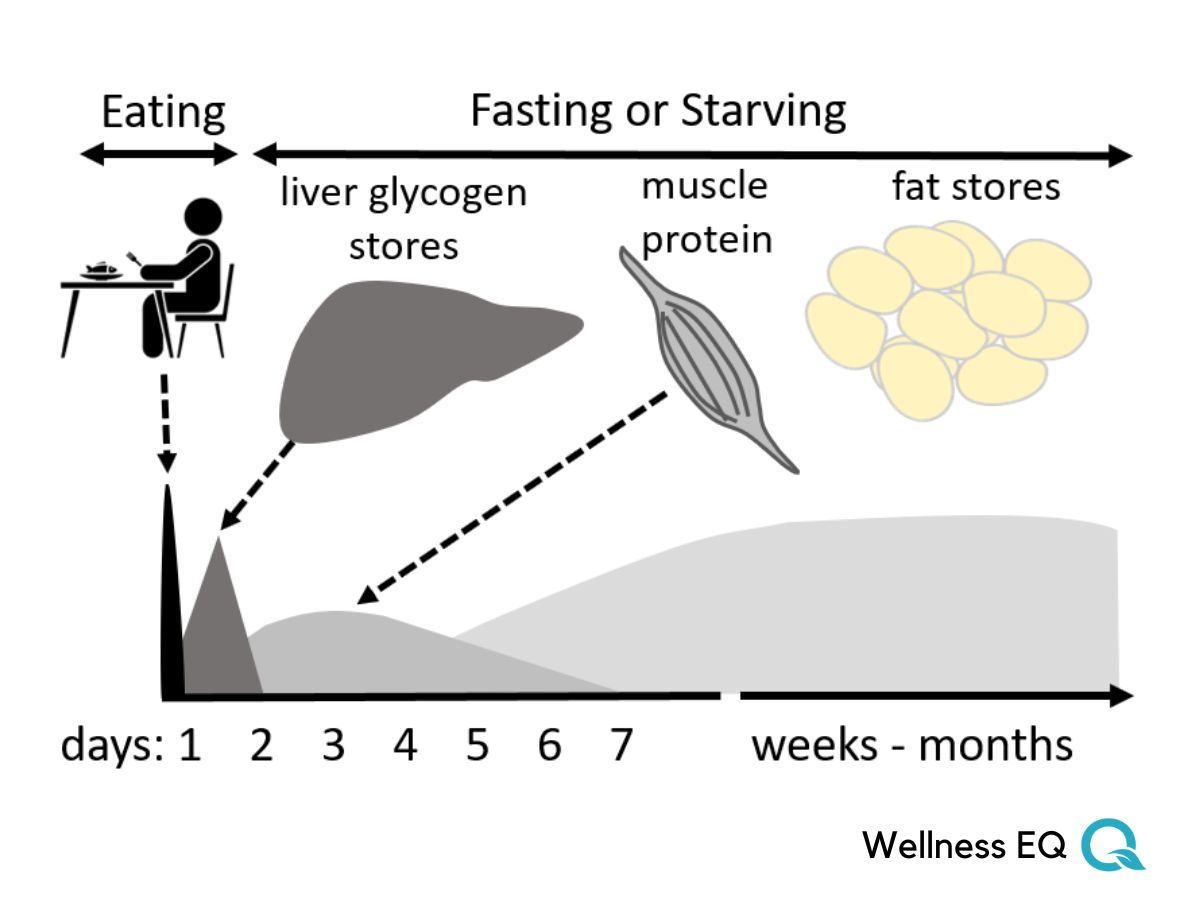
Starvation energy use
Brain energy requirements
Ketones are potentially a more efficient fuel to power our bodies and our brain. Our brain is the most energy-hungry organ in the body.
The adult human brain weighs about two to three percent of total body weight. In newborns, this ratio increases to thirteen percent.
The new-born’s brain energy requirement exceeds that of the rest of their body at a staggering 74 percent, while the adult brain requires much less, only about 20 to 23 percent.
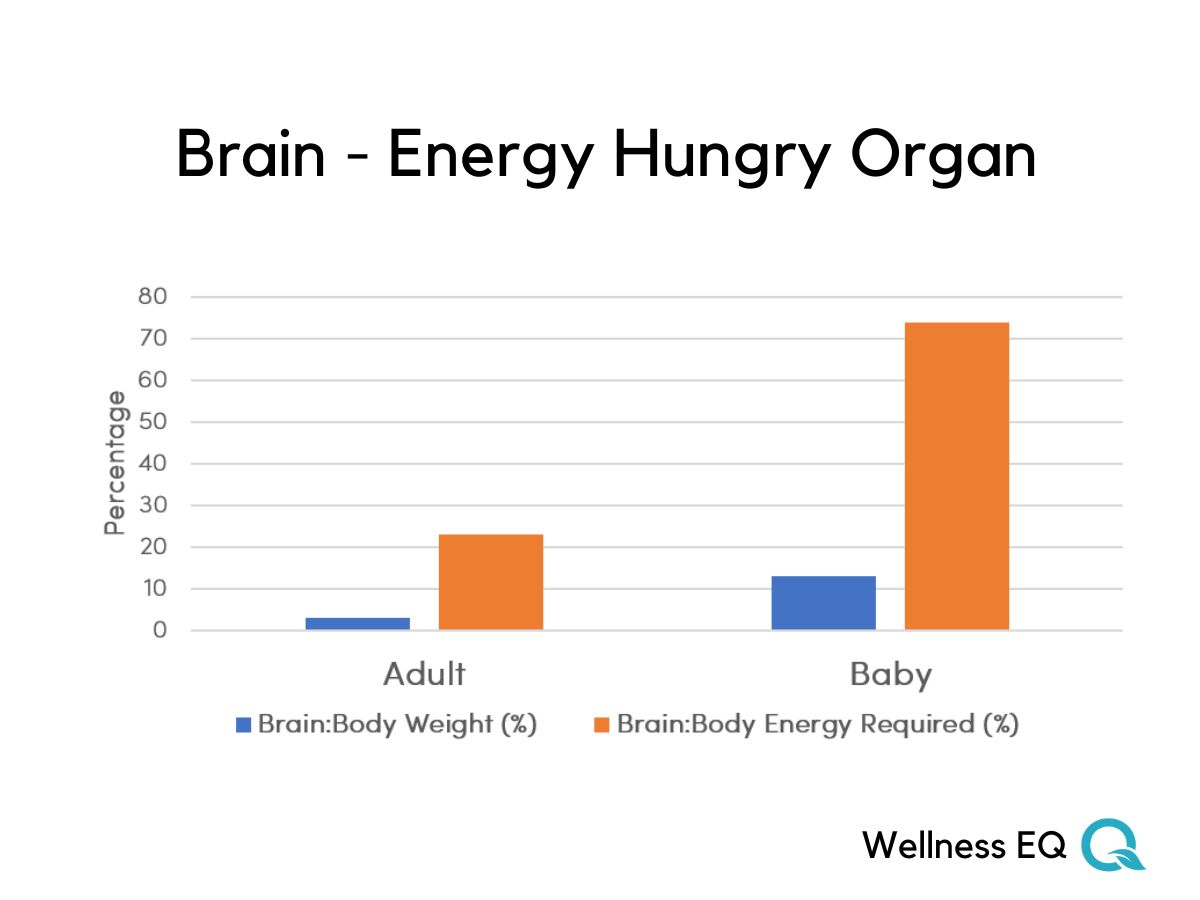
Brain - energy hungry organ
Food and our ancestors
Ketones were of great importance to ancient hunter-gatherer populations. They had to rely on it for their survival. Their diets consisted of nutrient dense food, high in protein and fat content.
Certain foods, such as wild plants and other edibles were only available seasonally, adding just a smattering of carbohydrates to their diet. The health benefits of their diet have been confirmed by archaeological evidence, since these populations did not suffer from the chronic diseases so prevalent today. They maintained overall health until death.
Carbohydrates cause energy deficiencies
One of the most critical hormones needed for energy production is insulin, but it is only needed when we use glucose for energy. Insulin is produced in the pancreas and is responsible for regulating blood sugar levels. High insulin levels follows when we eat carbohydrates.
A sugary or starchy meal will increase blood sugar levels, often above the normal limit – a condition called hyperglycaemia. Insulin will decrease blood sugar levels by transporting it into cells. This often leads to blood sugar levels often falling below the normal limit, called hypoglycaemia or a sugar crash.
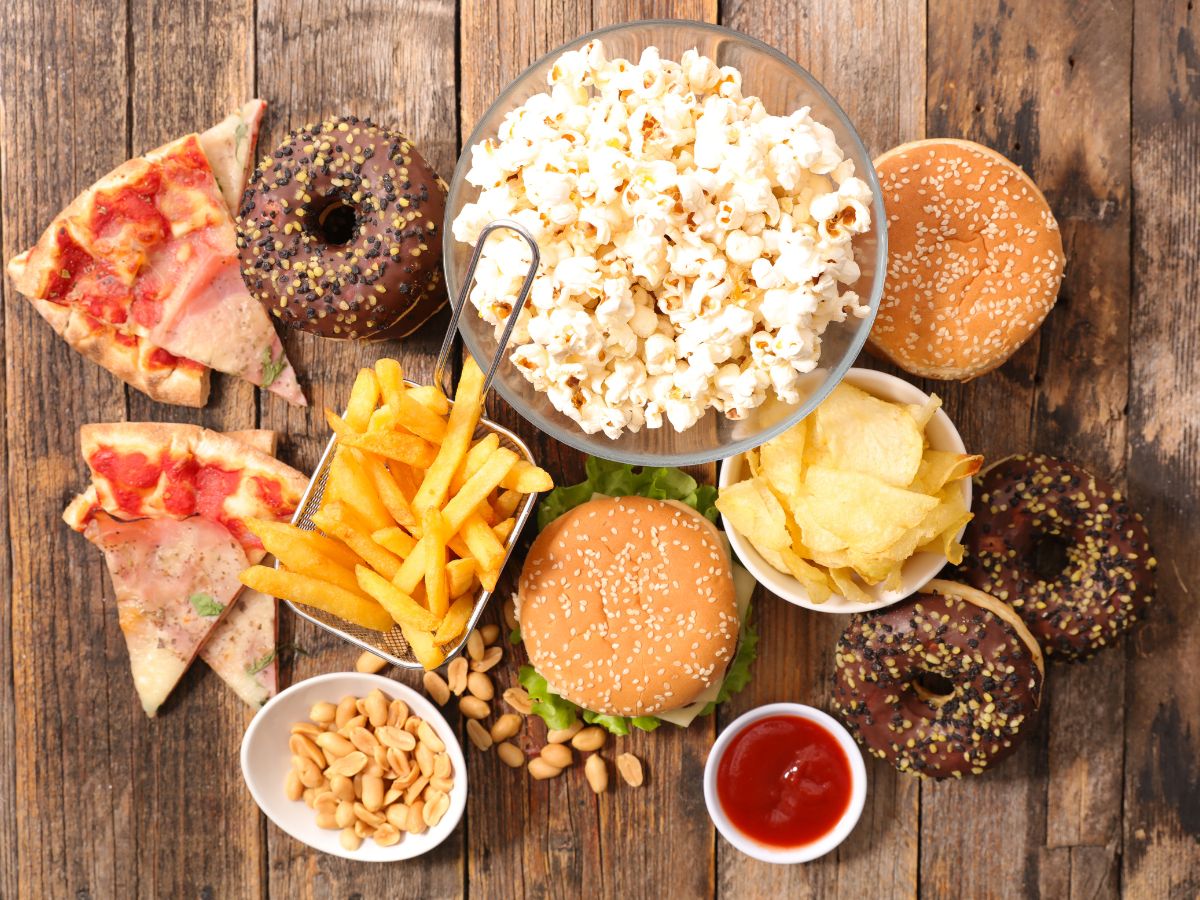
Western diet of simple carbs
The sugar crash
While refined carbs may give you a quick boost, the crash will come soon! When this happens, we feel hungry, and need to eat again. A pattern of high and low blood sugar levels emerges which looks like a roller-coaster ride! After years of this pattern the cells in our body stop responding to insulin, resulting in deficient energy production. We call this condition insulin resistance.
In our busy stressed society, people often fall victim to poor eating habits, which eventually result in poor health outcomes.
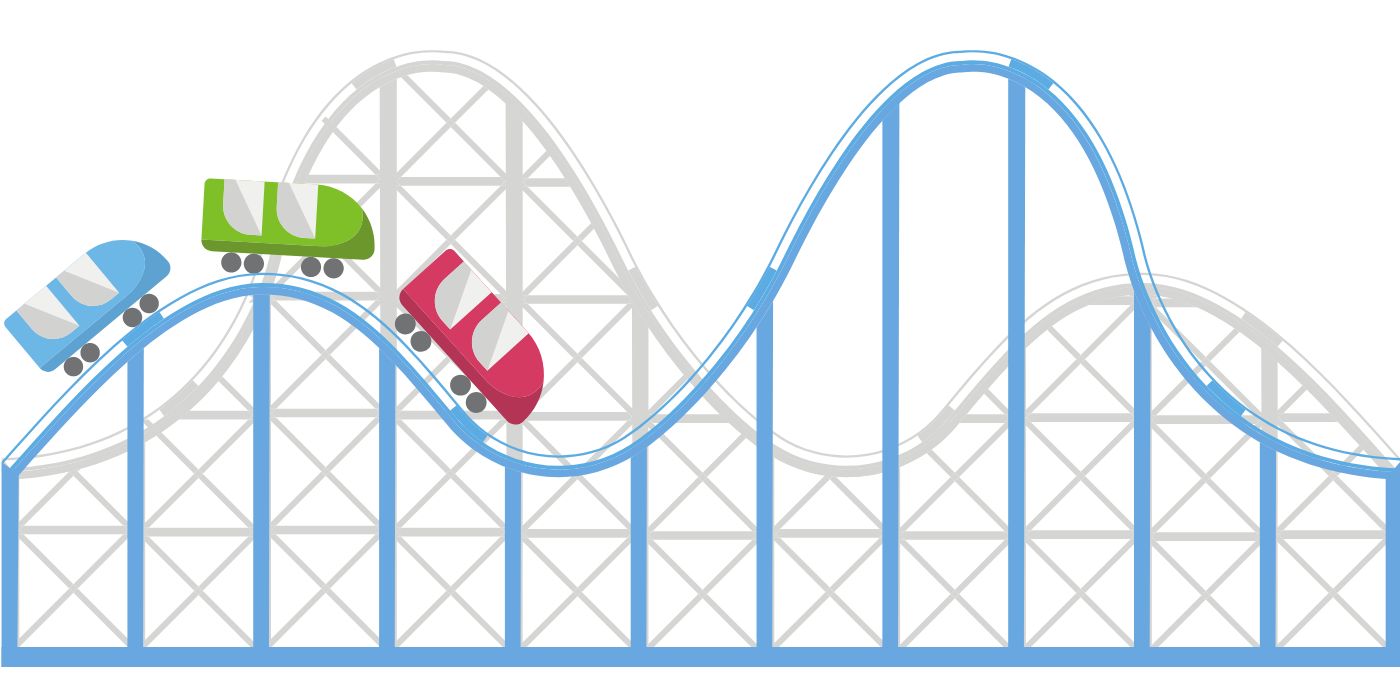
Eating and drinking starchy processed food and drinks result in a roller coaster ride of high and low glucose levels, tightly followed by spikes in insulin release.
Eating protein and fat boosts energy levels
When we eat protein or healthy fats, our body releases much less insulin. That means you don't go on the blood sugar roller-coaster ride. Eating full fat dairy products, eggs, fish and meat will keep your blood sugar levels stable and ensure that the body's required protein content is adequate.
The take away message is that eating healthy nutrients like protein (including red meat) and fat - including saturated fat - will boost your energy levels.
Overcome energy level deficiency by using your fat tank
The only way to address low energy levels in the body is to follow a diet with a low to very low carbohydrate content. This in turn will decrease insulin levels, and the body will switch to using body fat (ketones) for energy. They are able to power all the energy required for cellular processes, whether or not insulin resistance is present.
Diseases associated with low energy levels
High insulin levels are associated with weight gain and obesity. It also predicts the development of type 2 diabetes - up to a decade before the condition is clinically diagnosed.4
It may surprise many that cancer is also a disease associated with high insulin levels. What's more, breast cancer cells grown in the laboratory need insulin to survive, while normal breast cells don't. Many other cancers are also associated with high insulin levels: colon cancer, pancreas, oesophageal and prostate cancers.5
Even injecting insulin, a drug very commonly prescribed for type 2 diabetics, increases the risk of cancer. This is very concerning, especially since researchers from Cardiff and Bristol Universities found that the number of people using insulin to treat diabetes trebled between 1991 to 2010. The longer insulin is used for treatment, the greater the cancer risk.6
Energy-boost your life
A low carb/keto diet ensures that you continue to use your fat tank. It will ensure that all the cellular processes in your brain and body are powered, even if you are insulin resistant. Making simple changes to your eating habits will change your energy levels and health.
It will also decrease your chances of developing chronic illness such as diabetes, heart disease, cancer or Alzheimer's dementia. Our specially designed healthy eating courses will teach you step-by-step how to achieve this and lead a healthy and fulfilling life.
You can access our course here.
References
- Guerlac, Henry. Antoine-Laurent Lavoisier – Chemist and Revolutionary. 1973 New York: Charles Scribner's Sons. p. 130.
- Christofferson T. Ketones the Fourth Fuel. Amazon; 2020.
- Cahill GF Jr, Veech RL. Ketoacids? Good medicine? Trans Am Clin Climatol Assoc. 2003;114:149-61.
- Pories WJ, Dohm GL. Diabetes: have we got it all wrong? Hyperinsulinism as the culprit: surgery provides the evidence. Diabetes Care. 2012 Dec;35(12):2438-42.
- Leroith D, Scheinman EJ, Bitton-Worms K. The Role of Insulin and Insulin-like Growth Factors in the Increased Risk of Cancer in Diabetes. Rambam Maimonides Med J. 2011 Apr 30;2(2):e0043.
- Currie CJ, Poole CD, Evans M, Peters JR, Morgan CL. Mortality and other important diabetes-related outcomes with insulin vs other antihyperglycemic therapies in type 2 diabetes. J Clin Endocrinol Metab. 2013 Feb;98(2):668-77.
